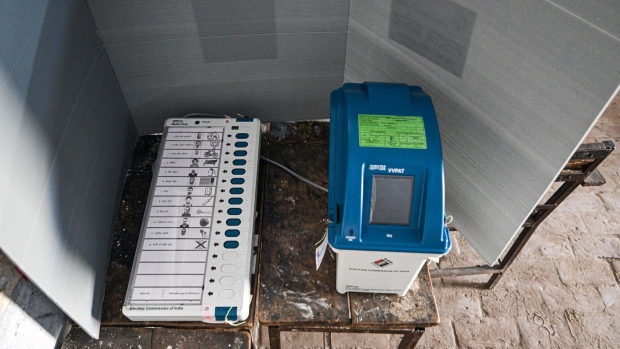Apr 26, 2024
India’s Supreme Court Rejects Plea for Paper Audit of Votes
, Bloomberg News

(Bloomberg) -- Sign up for theIndia Edition newsletter by Menaka Doshi – an insider's guide to the emerging economic powerhouse, and the billionaires and businesses behind its rise, delivered weekly.
India’s top court declined to order any changes to the counting of votes in the country’s on-going national elections.
Petitioners had demanded that the Election Commission of India verify each electronic vote cast with a paper slip generated at the time of voting.
The VVPAT, or voter-verified paper audit trail, generates a paper slip when a vote is cast using an electronic voting machine. The paper slip enables a voter to cross-check if their vote is registered accurately. India relies exclusively on electronic voting machines to conduct its elections. The voting machines were introduced to curb vote tampering, ballot-stuffing and coercion under the old system.
Currently, the verification process entails tallying votes with VVPATs from five randomly selected voting machines in each constituency.
More than 1 million polling stations, with 5 million voting machines are being used in the elections, which began on April 19 and will run until June 1. Results will be counted on June 4. About 970 million Indians are registered to vote. The second phase of the election across 13 states and covering 88 constituencies is currently underway.
Though the court reject the counting of paper ballots, it did give additional direction regarding the sealing and storing of the machines after polls. While affirming the reliability of the EVM system, the court also observed that “democracy is all about maintaining harmony and trust among its pillars.”
Prime Minister Narendra Modi is aiming to extend his decade in power by another five years, with his party boldly predicting it will win an even bigger mandate this time around having won the last two elections with large majorities.
The top court was hearing petitions filed by the Association of Democratic Reforms, or ADR, an independent election watchdog, as well as an individual petitioner. Both sought more transparency in the polling process.
ADR had argued that every voter should have a mechanism to ensure that their vote has been registered and will be counted. The second public interest litigation plea asked for a complete cross-verification of votes with the paper trails.
A voting machine lists the political party symbols of all contesting candidates and provides a button next to each entry. A voter simply presses the button against the candidate of their choosing. The machine then briefly displays the chosen candidate, allowing the voter to check their choice. The voter is then given an indelible ink mark on their finger from polling booth workers as a mark of having successfully voted.
India transitioned from the paper ballot system to electronic voting machines gradually since the 1990s. The move, however, hasn’t been free of criticism, with the losing party often accusing the winner of rigging the voting machines.
The VVPAT system was introduced to ward off some of the criticism with the top court fixing the number of voting machines to be randomly selected for cross-verification in 2013.
--With assistance from Swati Gupta.
©2024 Bloomberg L.P.








